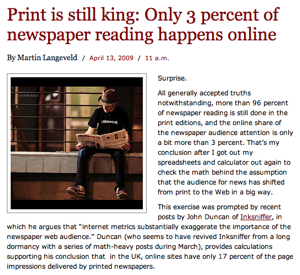Just how big is this opportunity? Pascal-Emmanuel Gobry was wondering at Business Insider which of the Groupon revenue and profitability guestimates are correct. He wrote:
We're still very bullish on Groupon and think its valuation was justified at whatever end of the spectrum its financials are, given the market and the brand. But its financial picture is still very hazy. Who has the details? Let us know!So I responded with a calculation based on Groupon's own data:
Why is the picture hazy? Groupon all but publishes its revenue in real time. Groupon's revenue is easy to estimate from the real-time stats they have on their site, plus estimates from sampling the deals to see what the average discount is. Here's my calculation based on the deal clock from Feb. 16 to April 4. Based on that period, revenue annualized to $150 million. However, it's growing rapidly, so $350 million is certainly possible.Clarification: my estimate of $150-200 million is after paying the merchant's 50 percent. So Groupon would actually report $300-$400 million in revenue on this basis.
3,001,657 "Total Groupons bought" as of 4/4
1,905,218 "Total Groupons bought" as of 2/16
1,096,439 Groupons bought in 47 days
23,328 Average number of Groupons sold per day, national total
543 Average number of sales per Groupon (per day total divided by 43 cities)
$141,593,040 "Total dollars saved" 4/4 (how much they saved customers)
$87,996,041 "Total dollars saved" 2/16
$53,596,999 Savings in 47 days
$92,408,619 Gross value (58% avg discount - based on a sampling of Groupons)
$38,811,620 Net revenue (42% actually paid by buyers)
$825,779 avg sales/day
$35.40 average individual sale/deal
$19,204 average total revenue per deal
$301,409,389 Current annualized sales pace (actual cash, not undiscounted value of deals)
$150,704,695 Groupon share of revenue at 50%
As to growth to a $350 million 2010 pace: the deals clock at this moment is at 4,007,360, the "dollars saved" clock is at $154,567,861. That's just 12 days after my prior benchmark on 4/4. So the deals pace is accelerating (83,808 daily deals sold per day in the past 12 days vs 23,328 in the prior 47 days). However, the value of the average deal is dropping, probably as Groupon moves into smaller markets. Based on the increase in dollars saved over the past 12 days, revenue has actually DROPPED to $782,963 per day, or a $142 million pace. Twelve days is not a good sample period, but this does suggest that the pace is leveling off. So I would say: they are heading for $150 to $200 million this year (assuming some additional growth and of course holiday spending uptick). I think expansion beyond this pace gets difficult, unless they find ways to (a) move into smaller markets, and (b) expand their demographic appeal beyond the young urban professional women who predominate right now.
I leave it to others to figure out what Groupon's costs are against this, but I suggest that a 50% operating margin is not out of the question - so, something in the $75-100 million range (EBITDA).
Update: based on another comment at Business Insider (questioning whether Groupon is a great idea from a merchant's perspective), I added this comment:
There's an interesting discussion of Groupon from the merchant's perspective in this thread at Groupon's own forums (goes on for 8 pages, well worth perusing).Update 2, April 17: Paul Butler did a bit more sophisticated data scraping and came up with some pretty similar numbers.
Merchants need to see Groupon as a marketing channel, not a sales channel. Yes, when they are the featured deal of the day, they'll sell hundreds of items or services at or below cost. But they don't do this every day, or even every month, because Groupon wants a lot of diversity in what it's offering. Again the math is worth considering:
Say you have a nail salon in Denver (nail jobs seem to be particularly popular on Groupon). You offer on Groupon a $75 service for $32 - close to the average discount. You sell 1000 of them, and Groupon pays you half the proceeds or $16,000. (You get that over 3 months, while the redemptions will probably spread over the next year, so you have a bit of cash flow advantage there.) Let's say your out-of-pocket cost for providing those services are $40 apiece or $40,000, so you're out $24,000. That's your marketing expense to get 1000 ladies (mostly) into your store, or $24 each. Do a good job and they come back. You have the opportunity to upsell each of them - do a $24 upsell and you've recouped your entire out-of-pocket expense. Plus you've had the marketing exposure of being on the Groupon site, being featured in Groupon's emails to thousands of members, etc. At the end of the day, you're certainly better off, if you do it right. And it's doubtful whether $24,000 in advertising on Denver radio, TV and print would bring 1000 people into your store.
 A year ago, in
A year ago, in